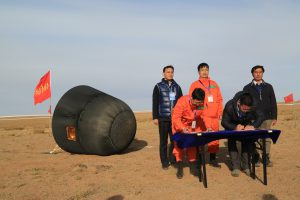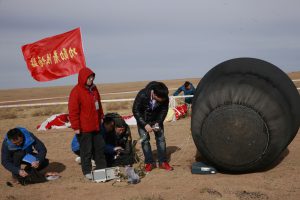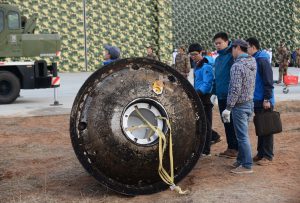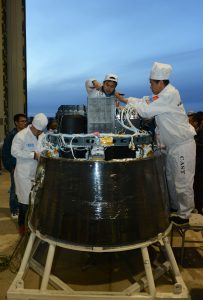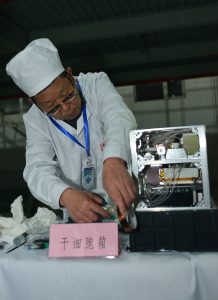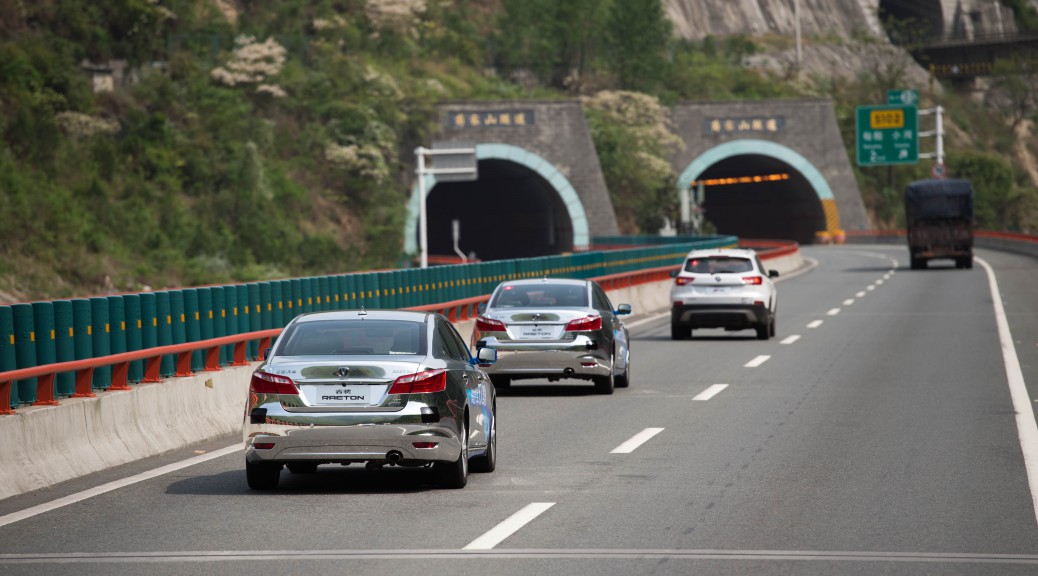刘媛媛软陶工作室的工作人员在制作玩偶。
买家在线传一张照片,卖家便能根据其需求设计卡通形象,并用软陶(一种人工低温聚合粘土)为其捏出新婚摆件、钥匙链等“私人订制”玩偶——这种创意如今已被36岁的刘媛媛在创业领域应用3年。在吉林长春市北郊一处家庭工作室内,刘媛媛平均每天会将百余个玩偶发货到全国各地,带动了近20名妇女就业。
Daily Archives: 04/28/2016
图片新闻:狗模特亮相宁波车展
我国首颗微重力科学实验卫星实践十号返回地球
Spotlight: China’s economic policy adjustment messages get accepted by int’l investors
BEIJING, April 16 (Xinhua) — International confidence in China’s economic future obviously improved following the release of key statistics for its economic performance in the first quarter on Friday, as people outside China have come to accept China’s “new normal” of slower growth between 6.5 percent and 7 percent.
David Dollar, senior fellow at the John L. Thornton China Center, Brookings Institution, said that macroeconomic measures put in place by the Chinese government have helped stabilize the economy, an improvement from several months ago when many were worried about “a hard landing.”
“All this obsession with a Chinese hard-landing I think is a bit too much,” Suan Teck Kin, an economist with the United Overseas Bank in Singapore, was quoted by Reuters as saying.
“Chinese economic data is showing signs of stabilization, including recent PMI numbers, as well as the latest figures on industrial production and retail sales,” Suan said.
China’s gross domestic product grew by an annualized 6.7 percent in the first quarter, with March industrial output surprising at 6.8 percent.
Its exports grew by 11.5 percent in March, the first expansion since June, though a lower base last year and seasonal factors associated with the Chinese New Year may be some distorting factors.
Retail sales in the first quarter rose by 10.3 percent from a year before, up from 10.2 percent in the previous quarter.
“The latest data are strong enough to show that despite its prolonged slowdown, China remains a main engine of global growth,” the Associated Press reported.
The AFP also said that “green shoots (are) appearing” even though the quarterly growth has slowed.
Challenges remain as China tries to push through a transition from growth driven by investment and exports to growth led by consumption and the services sector.
Some of the observers voiced concerns over the rise in corporate debt while acknowledging the signs of recovery.
However, the International Monetary Fund (IMF) said in a report on Wednesday that China’s corporate debt risks are rising but still manageable.
The IMF report said risks are concentrated in five sectors such as real estate, manufacturing, retail and wholesale, mining and steel, where earnings relative to interest expense have fallen despite declining nominal interest rates.
It estimates that bank loans potentially at risk in China amount to almost 1.3 trillion U.S. dollars, which could translate into potential bank losses of 756 billion dollars.
“This number may seem large but it is manageable, given China’s bank and policy buffers and continued strong growth in the economy,” said Jose Vinals, director of the IMF’s monetary and capital markets department.
In its latest quarterly forecast released earlier this week, the IMF raised its China growth projections for both 2016 and 2017 by 0.2 percentage point, a bright spot amid sluggish global growth.
Economists and analysts agree that the Q1 growth, though slowest in seven years, is in line with market expectations.
Chen Fengying, world economy research fellow with the China Institute of Contemporary International Relations, said people outside China have gradually come to accept the “new normal” of China as the authorities increased their communication efforts on the economic policies.
“The economists and investors outside China no longer expect 9 percent or faster growth,” she said. “It is a process of China’s messages of policy adjustments getting through to international investors.” Enditem
BiH, China should expand ties, deepen understanding: Presidency Chairman
by Han Jianjun
SARAJEVO, April 19 (Xinhua) — Bosnia and Herzegovina (BiH) and China should expand economic ties and the two sides will benefit from “16+1” cooperation, said BiH Presidency Chairman Bakir Izetbegovic here on Tuesday.
During an interview with Xinhua, Izetbegovic noted the two countries have a solid base for stable and friendly partnership.
“We can and we should expand our economic cooperation in the future for the mutual benefit,”said Izetbegovic.
He also highlighted the cooperation between China and countries in Central and Eastern Europe (CEE),or “16+1″cooperation.
“The idea of 16 + 1 cooperation, linking China as an economic powerhouse of the world with emerging economies of Central and Eastern Europe, is a great vision,” he said, adding “it can benefit both China and the region.”
He also talked about the coming Sarajevo Business Forum in May, which will be combined with the “16+1″economic and trade forum. Sarajevo Business Forum is one of the largest of its kind in the region.
On the Belt and Road Initiative, Izetbegovic said BiH is willing to play a role in it.
“We have a potential for growth, especially in the field of energy, and we need to connect more strongly with our region and with the rest of the world. We are working to develop our infrastructure, and China is welcome to play a role in that development.”
The BiH Presidency Chairman also noted the two countries should enhance bilateral understanding.
“There are two key areas I find crucial for deepening the understanding between China and BiH: culture and tourism,”he said, “Chinese guests are more than welcome in our country, and I hope there will be more of them in the future. I also hope many more BiH people will visit China.”
Izetbegovic said his country applied for the European Union (EU) membership, which made it more interesting to foreign investors, including Chinese investors.
He admitted there were a lot of work to be done before the application is accepted, but BiH was ready to overcome difficulties with negotiation, compromise and patience.
Izetbegovic, a member of the BiH Presidency since 2010, is the son of the first President of BiH Alija Izetbegovic. Enditem
Spotlight: China’s economic policy adjustment messages get accepted by int’l investors
BEIJING, April 16 (Xinhua) — International confidence in China’s economic future obviously improved following the release of key statistics for its economic performance in the first quarter on Friday, as people outside China have come to accept China’s “new normal” of slower growth between 6.5 percent and 7 percent.
David Dollar, senior fellow at the John L. Thornton China Center, Brookings Institution, said that macroeconomic measures put in place by the Chinese government have helped stabilize the economy, an improvement from several months ago when many were worried about “a hard landing.”
“All this obsession with a Chinese hard-landing I think is a bit too much,” Suan Teck Kin, an economist with the United Overseas Bank in Singapore, was quoted by Reuters as saying.
“Chinese economic data is showing signs of stabilization, including recent PMI numbers, as well as the latest figures on industrial production and retail sales,” Suan said.
China’s gross domestic product grew by an annualized 6.7 percent in the first quarter, with March industrial output surprising at 6.8 percent.
Its exports grew by 11.5 percent in March, the first expansion since June, though a lower base last year and seasonal factors associated with the Chinese New Year may be some distorting factors.
Retail sales in the first quarter rose by 10.3 percent from a year before, up from 10.2 percent in the previous quarter.
“The latest data are strong enough to show that despite its prolonged slowdown, China remains a main engine of global growth,” the Associated Press reported.
The AFP also said that “green shoots (are) appearing” even though the quarterly growth has slowed.
Challenges remain as China tries to push through a transition from growth driven by investment and exports to growth led by consumption and the services sector.
Some of the observers voiced concerns over the rise in corporate debt while acknowledging the signs of recovery.
However, the International Monetary Fund (IMF) said in a report on Wednesday that China’s corporate debt risks are rising but still manageable.
The IMF report said risks are concentrated in five sectors such as real estate, manufacturing, retail and wholesale, mining and steel, where earnings relative to interest expense have fallen despite declining nominal interest rates.
It estimates that bank loans potentially at risk in China amount to almost 1.3 trillion U.S. dollars, which could translate into potential bank losses of 756 billion dollars.
“This number may seem large but it is manageable, given China’s bank and policy buffers and continued strong growth in the economy,” said Jose Vinals, director of the IMF’s monetary and capital markets department.
In its latest quarterly forecast released earlier this week, the IMF raised its China growth projections for both 2016 and 2017 by 0.2 percentage point, a bright spot amid sluggish global growth.
Economists and analysts agree that the Q1 growth, though slowest in seven years, is in line with market expectations.
Chen Fengying, world economy research fellow with the China Institute of Contemporary International Relations, said people outside China have gradually come to accept the “new normal” of China as the authorities increased their communication efforts on the economic policies.
“The economists and investors outside China no longer expect 9 percent or faster growth,” she said. “It is a process of China’s messages of policy adjustments getting through to international investors.” Enditem
News Analysis: Chinese companies’ overseas M&A growing at normal speed
BEIJING, April 19 (Xinhua) — The Ministry of Commerce (MOC) on Tuesday denied that Chinese companies were on a global buying spree and said the speed of their overseas mergers and acquisitions (M&A) was “appropriate and normal.”
“It is an overstatement to say Chinese companies are ‘buying out the world’ as such a claim confuses finalized deals with those that are pending approval,” said MOC spokesperson Shen Danyang at a news conference.
In the first quarter (Q1) of 2016, cross-border M&A value rose to 324 billion U.S. dollars, 14 percent higher than Q1 of 2015, while volume dropped 10 percent to 1,202 deals due to the economic slowdown in China, the potential exit from the EU by the U.K., volatile equities markets and the fall in commodities prices, according to the quarterly cross-border M&A index released by international law firm Baker & McKenzie on Tuesday.
Overseas M&A deals by Chinese companies in Q1 was 16.56 billion U.S. dollars, a far cry from the 113 billion dollars cited by some reports, Shen said.
Instead of the rumored 100 billion dollars, Shen said that the worth of overseas M&A deals by Chinese companies last year was 40.1 billion dollars, a mere 6.2 percent of the world’s total M&A market value.
Baker & McKenzie pointed out that outbound deals from China covered a number of sectors including chemicals, business services and consumer goods, revealing a desire to access advanced manufacturing techniques and technological know-how to build global brands.
The biggest deal of Q1 2016 was the takeover of Swiss agrichemical company Syngenta by state-owned ChemChina for 45.8 billion U.S. dollars, as it attempts to boost its agricultural output in light of increased food consumption by the growing middle classes.
Although Chinese companies have increased transnational acquisition in recent years, their M&A and China’s overseas investment were both in the early stages, Shen said.
According to Shen, Chinese overseas investment only accounts for 3.4 percent of the world’s total, while the figure for the United States is 24.4 percent. China trails behind other developed economies such as the United Kingdom, Germany, France and Japan.
Overseas M&A by Chinese companies create win-win results, he said, citing the acquisition of AMC Entertainment by Dalian Wanda Group in 2012. The deal helped AMC turn losses into profits the same year, and be listed on the New York Stock Exchange the subsequent year, while some 1,100 new jobs were created in the United States.
“We are seeing a shift in Chinese investment from emerging markets to developed economies, and from energy and natural resources to technology and financial services, as Chinese companies target brands, talent and other assets that help increase their competitiveness at home and abroad,” said Zhang Danian, chief representative of Baker & McKenzie’s Shanghai office.
“We expect this trend to continue for the rest of 2016, as China’s economy stabilizes and the country transforms from a low-end manufacturing-led economy to one that focuses on consumption and services,” Zhang added.
Shen proposed more government support for Chinese companies to help them with overseas M&A as they still lack experience of dealing with cultural differences and policy hurdles. Enditem
China committed to tackling steel overcapacity — official
BRUSSELS, April 19 (Xinhua) — The Chinese government has taken the most concrete actions in the world to tackle current excess capacity in the steel sector, a high-ranking official with China’s Ministry of Commerce told Xinhua Monday.
“As a major steel-producing, -consuming and -trading country and a major importer of raw materials, China is making enormous endeavors and paying enormous prices to cut excess capacity in the steel sector,” Zhang Ji, China’s assistant minister at the Ministry of Commerce, said after attending a steel meeting in Brussels.
The Chinese government has ceased to license steel projects and started to close outdated plants and eradicate “zombie” companies.
Zhang said early efforts have achieved remarkable results, noting that China had cut over 90 million tons of obsolete capacity during the 12th Five-Year period.
The State Council, China’s cabinet, announced earlier this year that crude steel production capacity will be slashed by 100-150 million tons over the next five years. It is estimated that 500,000 laid-off workers will have to be resettled.
“To make sure that excess capacity will be eliminated in an orderly manner, the central government has allocated an earmarked fund of 100 billion yuan (15.45 billion U.S. dollars), which will be used to resettle workers,” the official said.
Besides, the Chinese government is also committed to expanding domestic demand for steel products, which has a lot of potential as the Chinese economy will maintain a medium-high growth, Zhang said.
One measure is to start necessary large-scale infrastructure development projects.
“In the future, China will promote the use of steel structures in buildings and greatly increase the proportion of steel structures when rebuilding shanty areas and dilapidated houses and implementing anti-seismic housing projects,” he said.
Currently, only 5.6 percent of Chinese buildings use steel structures. China plans to increase that proportion to over 20 percent, which would need an extra 20 million tons of steel products a year.
“In addition, China will take measures to stabilize the consumption of major steel-consuming industries and increase and upgrade the use of steel products in automobiles, machinery equipment, the power and shipping sectors,” he added.
“It is the slow recovery of the world economy that causes a sluggish demand for steel products, which further leads to the overcapacity issue in the steel sector,” he said, responding to accusations that China is the cause of global steel overcapacity.
Meanwhile, the assistant minister stressed that as a major producer and consumer of steel, China’s steel products are mainly for domestic use.
“In recent years, 85-95 percent of steel produced by China have been for domestic consumption. China’s annual steel consumption accounts for 45 percent of the global total,” he said.
China used to be a net importer of steel before 2005 and is still the fifth-largest importer of steel in the world.
“China imported the equivalent of 13.57 million tons of crude steel in 2015,” he said, adding that China has thus contributed to the stable development of the global steel industry.
Moreover, rather than dumping steel in other countries, the Chinese government has in recent years implemented measures such as export tariffs on some steel products to reduce exports.
“The export tariff for billet is 20 percent and for hot-rolled wire rod 15 percent,” he said.
Many countries facing difficulties in the steel industry tend to adopt trade protectionist measures, which is incorrect, the trade official said, adding that frequent use of trade remedy measures and other import-restrictive measures is detrimental to the international cooperation on division of labor, cooperation and rational layout of the global steel industry.
According to statistics from the World Steel Association, world output of crude steel in 2015 was 1.62 billion tons, and the average capacity utilization rate was 69.7 percent, 3.7 percentage points lower than the 73.4 percent in 2014, which shows that the problem of global overcapacity is growing worse.
Besides China, steel-producing countries and regions like the United States and the European Union have also been plagued by overcapacity to different degrees.
Therefore, Zhang called on all steel-producing, -consuming and -trading economies and raw material supply economies to step up communication and policy coordination and jointly try to tackle the challenge of steel overcapacity, stressing that a “shared problem needs to be tackled with shared efforts.”
Zhang also expressed the hope that more economies can take active measures to jointly contribute to resolving the problem of global steel overcapacity.
“China is ready to step up communication, exchange of views and cooperation with other parties, and share its experience and practices related to excess capacity in the steel industry,” he said. Enditem
China’s FDI to maintain steady growth this year: Commerce Ministry
BEIJING, April 19 (Xinhua) — Foreign direct investment (FDI) in China will likely sustain steady growth this year, the Ministry of Commerce (MOC) said Tuesday, highlighting robust inflow in western regions and acquisitions.
“It [annual FDI] may not increase very fast but will maintain the growth momentum seen last year and in the first quarter [Q1] of this year,” MOC spokesperson Shen Danyang told reporters.
FDI in western regions posted strong growth in Q1, outpacing the national total with a 42.5 percent jump year on year to reach 21.3 billion yuan (3.3 billion U.S. dollars), he said.
Great potential in the service industry and a relatively low base of comparison contributed to the surge in western regions, Shen explained.
FDI to the Chinese mainland rose 4.5 percent year on year to 224.2 billion yuan in Q1, slowing from 6.4 percent in 2015. But year-on-year growth in March was higher at 7.8 percent, official data showed.
Shen said mergers and acquisitions (M&As) were more active, playing an increasing role in FDI growth.
Investment inflow in the form of M&As rose 32.6 percent year on year in Q1 to 7.8 billion U.S. dollars. It accounted for 22.7 percent of the overall FDI, up from 17.9 percent a year earlier, according to Shen.
M&As by foreign investors remained active in China, he said, counter to a recent report by accounting firm KPMG, which claimed inbound deals fell last year.
The number of foreign-invested M&A deals rose 14.4 percent to 1,466 in 2015, with realized investment soaring 137 percent to 17.8 billion U.S. dollars, Shen noted.
The Chinese government continues to welcome foreign investment through M&As, he said. Enditem
Chinese central bank pumps more money into financial system
BEIJING, April 18 (Xinhua) — The central bank pumped 162.5 billion yuan (about 25 billion U.S. dollars) into the financial system on Monday in open market operations via medium-term lending facility (MLF).
MLF is a tool introduced in 2014 to help commercial and policy banks maintain liquidity by allowing them to borrow from the central bank by using securities as collateral.
The fresh funds were injected into 18 financial institutions, according to the People’s Bank of China (PBOC).
A total of 83.5 billion yuan is for three-month MLF and 79 billion yuan is for six-month MLF, at interest rates of 2.75 percent and 2.85 percent, respectively.
The interest rates were left unchanged to “guide financial institutions to boost support for key areas and vulnerable links in the national economy,” the central bank said.
To bolster the lukewarm economy, China has adopted a more pro-growth policy stance, cutting benchmark interest rates and banks’ reserve requirement ratio (RRR) multiple times since 2014.
The country’s GDP grew 6.7 percent year on year to reach 15.9 trillion yuan in the first quarter, according to the National Bureau of Statistics (NBS).
The growth further narrowed from the previous quarter’s 6.8 percent, which was already the lowest quarterly rate since the global financial crisis. Enditem
China remains world’s largest trademark holder
BEIJING, April 19 (Xinhua) — China remains first in the world in terms of the number of trademark applications, official data showed on Tuesday.
In 2015 alone, China received more than 2.8 million trademark applications, four times the number in 2008. China has led the world in the number of trademark applications since 2002, according to the State Administration for Industry and Commerce (SAIC).
The SAIC had received more than 19.1 million trademark applications as of March this year, and the number of valid trademarks registered in China totaled 10.7 million by the end of March.
Liu Junchen, deputy head of the SAIC, said at a press conference on Tuesday that the surge in trademarks was a result of China’s continued efforts to protect intellectual property.
However, Liu admitted that only a small proportion of Chinese brands are recognized in the international market as Chinese enterprises still rely too much on cost advantages.
Liu said that, in the future, the SAIC will continue to safeguard intellectual property, streamline registration procedures and toughen penalties for trademark infringement. Enditem
China sets major tasks for reform in 2016
BEIJING, April 16 (Xinhua) — China’s top economic planner has listed major tasks in propelling economic reforms this year, including reforms of state-owned enterprises (SOE), market supervision, investment, urbanization, opening up and innovation.
China will initiate mixed-ownership pilots in SOEs and push forward reforms in electricity, oil, natural gas and salt industries, said a statement issued after a two-day meeting of the National Development and Reform Commission (NDRC), held on Thursday and Friday.
The government will further cut red tape and improve market supervision, including compiling a negative list to enhance market access regulation. Market threshold of some major industries will be lowered for investors, and the current investment and financing mechanism will be improved, according to the statement.
China will implement the household registration reform to urbanize more rural migrants with a plan to help 100 million people settle in cities.
The country will continue to push forward opening up, stepping up the Belt and Road construction, promoting international production capacity cooperation, further opening service and manufacturing sectors, and establishing a negative list for foreign investment.
The government will also better its support for innovation and entrepreneurship.
Other tasks include accelerating a pricing reform in electricity, medical services and transport, and improving the way China uses natural resources and protects the environment. Enditem
Interview: China’s financial market undergoes big transformation, spurs economic growth: Deutsche Bank CEO
BEIJING, April 19 (Xinhua) — China’s financial market is undergoing a tremendous transformation, which will generate more opportunities for the Chinese economy in the years to come, Deutsche Bank co-Chief Executive Officer John Cryan told Xinhua here recently.
The Frankfurt-based bank executive made his first trip to China after taking realm as Deutsche Bank’s co-CEO in July 2015, in hopes of studying the bank’s local business firsthand.
“China is a strategic market for Deutsche Bank” and there are “growth opportunities in every one of (the bank’s) key business areas here,” he said.
“When I think of China, I think of a person in their 30s running a marathon,” he said. “Since the 1980s China has made great strides toward rapid economic growth and globalization. It’s amazing what China has achieved in such a short period, and the journey is far from over.”
According to him, there is room for the further development of China’s economy, especially in the service and consumer industries. In parallel, “a strong, flexible and globally connected financial system would be able to support (China’s) economic growth in more complex ways,” he noted.
The banker thinks the Chinese government has been doing a fairly good job in managing a difficult transition process in which the old drivers of growth — infrastructure and property investment and exports — are giving way to consumption-led growth.
“With the adoption of prudent and supportive monetary and fiscal policies, the (Chinese) authorities have ensured that growth has slowed down gradually, consumer prices have been broadly stable and rising employment has been sustained,” Cryan said.
“Services have taken over from manufacturing as the main source of growth and employment, the private sector is expanding and median household income growth in China continues to rise at an enviable pace, more than 8 percent in real terms last year,” he further explained.
“I see some similarities in the Chinese transition process,” Cryan added. “First, the shift from old to new growth drivers has a geographic dimension. It is a great responsibility and hugely complicated to forge a macroeconomic policy for an increasingly heterogeneous economy,” he said.
“Second, often lost among the news about restructuring pain is the fact that China – like Deutsche Bank’s home country Germany – is making great strides in advancing technology in manufacturing and services. This will help China and Germany to forge ahead economically in the years ahead. When current expectations stabilize, companies will increase their investment and global trade will regain its momentum. This will help Europe and China,” Cryan added.
With regard to the performance of the Chinese currency renminbi, RMB or yuan, Cryan thinks the RMB has moved to the center stage in the global arena, creating many promising trade and investment opportunities.
“The ongoing stability of the RMB exchange rate against the established basket has significantly improved the credibility of the newer framework of the managed floating RMB exchange rate against a trade-weighted basket,” said the financial expert.
“More importantly, it has eased the fear of RMB devaluation and helped stabilize market expectations about the RMB exchange rate,” he added. Enditem
Daimler launches car-sharing service in China
CHONGQING, April 15 (Xinhua) — German carmaker Daimler on Friday launched its car2go rental service in southwest China’s Chongqing Municipality, marking its entry to the Asian market.
The service, already popular in Europe and North America, allows users to access nearby for-rent cars via a mobile app, saving them the lengthy paperwork and other inconveniences of the traditional car rental business.
Sam Guo, COO of car2go China Co., Ltd., said 400 Mercedes-Benz Smart vehicles will be available for rent in the city. Users can park their cars anywhere in an area of 60 square kilometers in the city after use.
“China is our third key market after North America and Europe,” Guo said.
Rainer Becker, CEO of car2go China, said they hope car2go can alleviate the traffic congestion in many big cities. Chongqing was selected as their first step in Asia given its supportive government and the locals’ high acceptance of new ideas.
The company said it will add more cars and launch the service in more cities, if this model proves popular. Enditem
China long-distance oil and gas pipelines likely to exceed 160,000km by 2020, experts
STOCKHOLM, APRIL 28, (Greenpost) — The total length of China’s long-distance oil and gas pipelines is likely to exceed 160,000 kilometers by the end of 2020, with gas storage working capacity likely to reach 10.5 billion cubic meters and LNG receiving capacity to reach 19 million tonnes/year, industry experts predicted during China International Pipeline Exhibition 2016.
There is still great potential for global oil and gas pipeline construction market in spite of the sluggish international oil price, said Zhao Yujian, head of China Petroleum Pipeline Bureau (CPP), noting China’s Belt and Road Initiative would bring new opportunities for international oil and gas pipeline development, according to a report by the Xinhua-run Economic Information Daily on Monday.
China currently has 120,000 kilometers of oil and gas pipelines, accounting for less than 3 percent of the world’s total while natural gas consumption only takes up 6 percent in primary energy consumption, far less than the target of reaching a world average level of 24 percent, according to Zhao.
China is expected to show more and more robust demand for oil and gas especially clean energy such as natural gas and LNG which post great potential for oil and gas storage and transportation facilities, Zhao said. Enditem
China launches yuan-denominated gold benchmark in Shanghai
STOCKHOLM, APRIL 29(Green Post)–China launches yuan-denominated gold benchmark on Tuesday in Shanghai as it seeks to secure more sway in the pricing of the precious metal.
The Shanghai Gold Benchmark Price (code: SHAU), is the quote for trading of 1kg, 99.99 percent purity bullion, denominated in the Chinese yuan and derived from multiple rounds of trading.
The benchmark was set at 257.97 yuan per gram on Tuesday, the Shanghai Gold Exchange (SGE) said in a statement.
The benchmark also lays the foundation for shifting bullion trading in Shanghai from mostly spot to derivatives to increase the appeal of yuan-denominated bullion trading as financial instruments for both domestic and global investors.
SGE Chairman Jiao Jinpu said the launch of the benchmark offers the opportunity to develop bullion trading in China’s financial markets and encourage more participation by global investors.
Standard Chartered Bank (China) Ltd. and ANZ Bank (China) Ltd. are among 12 fixing members for the benchmark trading. The other ten members are domestic banks.
The trading margin is set at 6 percent and transaction fees are exempted until June 30 this year. Enditem















